Mitch Mitchell, Sarah Thibault and Yannick Pouliot revisit the decorative arts and reflect on ornamentation, domesticity and history at the Château Dufresne, Musée et site historique et patrimonial.
A Beaux-Arts style mansion built between 1915 and 1918, the Château Dufresne has considerable appeal owing to the opulence and coherence of its interior decoration. It is distinguished by the sheer abundance, variety and luxury of its ornamentation.
Still mostly visible today, the decoration of the residences of the first occupants, Oscar and Marius Dufresne, attests to the eclectic tastes of the middle class in the early 20th century. The mansion’s borrowing and mixing of styles, which range from Louis XV, Louis XVI and Second Empire to Italian Renaissance, Tudor and Elizabethan, are evident as one goes from room to room. They are also fully consistent with the interior decoration practices that were employed in the great manor houses of the period, which made use of luxury items purchased from suppliers’ catalogues.
Artists Mitch Mitchell, Yannick Pouliot and Sarah Thibault, whose works are being presented here, have likewise drawn on past resources that are accessible again today in many print and online publications.Relying on the enduring fascination with past opulence and its staging in historical museum reconstructions, these contemporary artworks generate new discoveries. They provide an opportunity to reflect on the older styles revisited and on the type of museology that showcases them, revealing aspects that tend to be passed over in the usual interpretations.
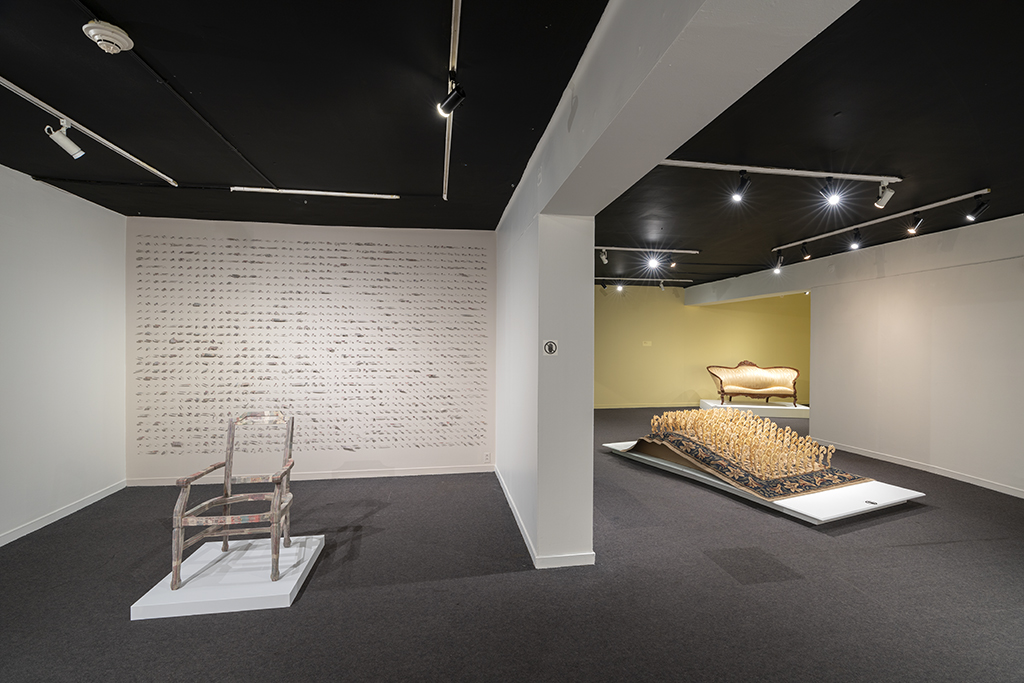
From 1965 to 1968, the Château Dufresne was home to the Musée d’art contemporain de Montréal, an institution that is still evolving today with a new phase of expansion into Montréal’s downtown core.Alluding to the building’s former use, the current exhibition invites artists to reinterpret and comment on past styles in relation to the interior decoration and furniture of the Château, and to examine the historical construction that is a key feature of the mission of this museum and heritage property.
Mitch Mitchell’s Yesterday’s Peoples, Tomorrow’s King (2017-2018) refers to the Louis XVI style of furniture as a return to classicism and explores the concept of artisanal skill or know-how. Yannick Pouliot’s more baroque-looking Se suffire à soi-même (2005) makes use of exuberance to underline the sometimes ostentatious character of interior decoration and reveal the foibles of human nature. Sarah Thibault’s Cultiver les fleurs du tapis (2017) returns to a plant pattern that has been a recurrent motif in decorative art and uses it to underscore its original character as well as the distancing from Nature that has occurred through its interpretation as ornamentation.
This selection of contemporary artworks provides fresh interpretations of the objects and decorative artefacts that lie at the heart of the Musée’s mission. They offer resistance to the nostalgic gaze that is often encouraged by historical reconstructions and invite us to step back in order to become more fully aware of the realities of the present and the past.
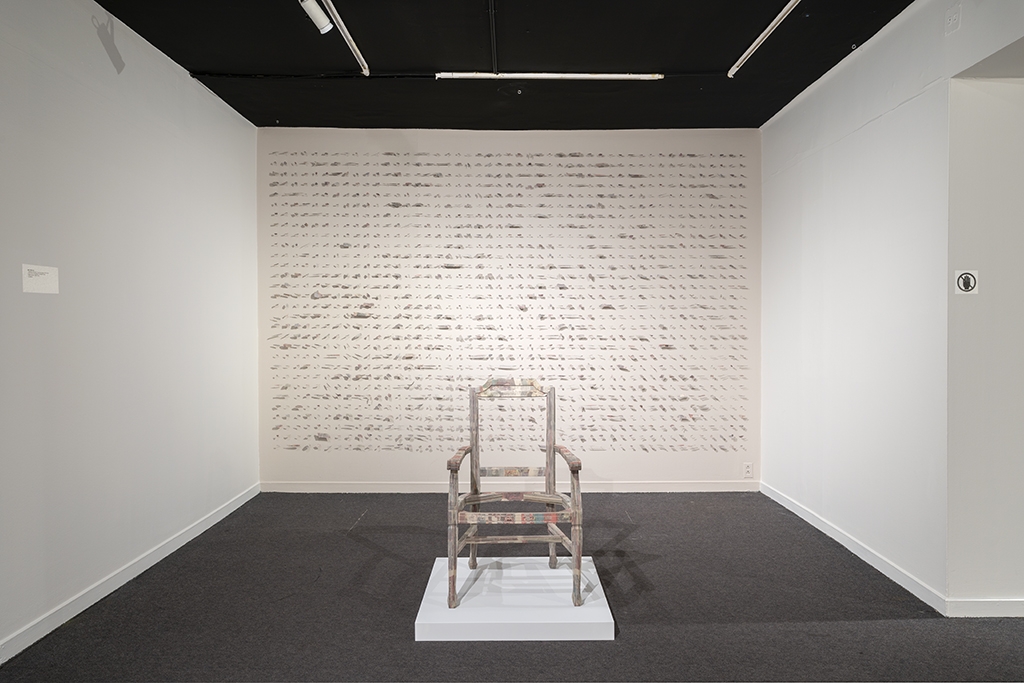
The Louis XVI style marked a return to Classicism during the reign of the last king of France before the French Revolution. By quoting this style, Mitch Mitchell refers (as the title of his work suggests) to this historical turning point contemporaneous with the end of a violent regime.
Mitchell’s work, part of which was completed at the Symposium international d’art contemporain in Baie-Saint-Paul, was made using newspapers from Charlevoix and Montréal. Although still recognizable from their colours, they have been rendered illegible in order to provoke reflection on power, public governance and the growing influence of the media, and as a comment on the rapidly approaching obsolescence of daily news. In this way, Mitchell juxtaposes media noise and the rupture brought about by a critical moment in history, such as that of the French Revolution.
As part of further reflection on craft-related skills, the artist’s reproduction of a Louis XVI armchair is the result of a long process that began with the fabrication of materials from pages that were painstakingly glued together in layers and then compressed and slowly air-dried. With these, the artist sculpted the chair legs by hand, using traditional assembly techniques. Borrowing some of the production processes used to make IKEA-type furniture, and working with particles of compressed paper, Mitchell has underscored the differences between artisanal and industrial production methods—the first is reserved for an elite while the second “serves” masses made anonymous by the consumption of standardized objects.
A classic example of the Louis XVI armchair on display at the Château echoes Mitchell’s chair. Unlike the baroque exemplar, Mitchell’s attests to the desire of the powerful to operate more discreetly and to even show a degree of modesty in a time of impending uprisings. An inlaid cigar box that was made from fine wood, and that required the meticulous application of considerable skill, stands in contrast to Mitchell’s use of recycled newsprint. Both practices are inscribed within distinct social economies and contexts that, in proximity, constitute a kind of comment on the times in which we live.
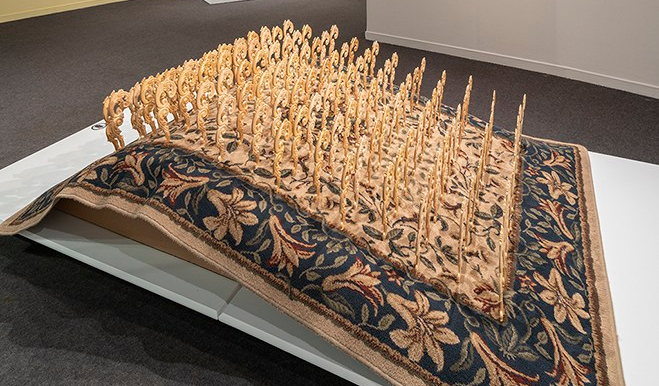
Sarah Thibault’s approach to art-making involves the appropriation of signs and symbols from the decorative arts tradition. Intimate in its proximity to daily life and ostentatious in its sumptuousness (intended to impress gallery-goers), her repertoire of ornamentation is an interesting compendium of natural and artificial, private and public—it contains the building blocks of a personal space as well as props used in the staging of power relationships.
Thibault’s reappropriation is rooted in the desire to mock these attributes of power and magnificence and to free herself from them using ludic presentation strategies. To begin with, the title Cultiver les fleurs du tapis alludes to the Québec expression s’enfarger dans les fleurs du tapis, which means to let oneself get tripped up by imaginary obstacles or problems. Meanwhile, the invitation to “plant your garden” can be seen as a form of resistance intended to keep us from turning in circles—in keeping with the idiomatic play metaphor.
Moreover, the orthogonal patterning, which is somewhat reminiscent of a garden plot, appropriates a traditional carpet motif while also underscoring its naturally flora character—one has the impression that industrious watering has made it stand up straight. The physical working of the soil stands in opposition to the ostentatious stylization of Nature, which displays richness and luxury and even a power used to domesticate land.
The bronze andirons on display also attest to this role of ornamentation. And their shape recalls the mass-produced, decorative-wood appliqués recycled and used by the artist.
Thibault’s approach is based, therefore, in the desire to “take back power.” It makes fun of the attributes of power and magnificence in order to liberate us from them by using ludic presentation strategies. In this way she strives to create a conversation addressing the extent to which the scope of power reaches into the intimacy of our domestic lives.
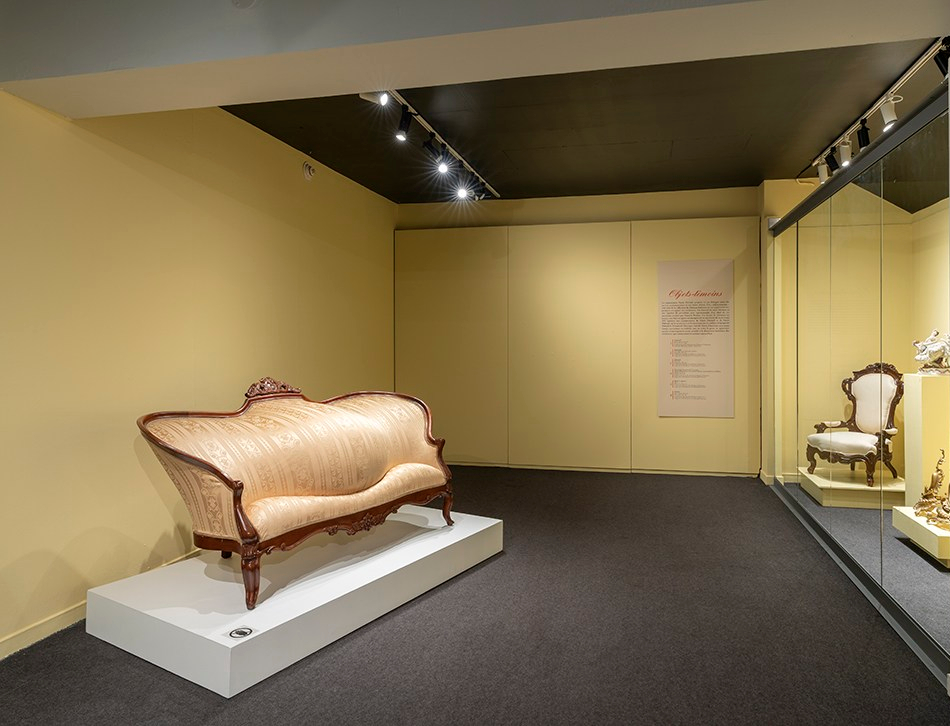
The unusual shapes of Yannick Pouliot’s art pieces draw on 18th- and 19th-century styles of furniture. He reconfigures them in ways that undercut their functionality and play on their anthropomorphic resonances.
These disjointed, oversized and collapsed pieces of furniture preclude any possibility of normal use. The overall shape of the chair back and the quality of the fabric used in Se Suffire à soi-même are apparently faithful, stylistically speaking, to the Baroque style to which they refer; but the back, which swells outward like a full belly, makes it impossible to sit down. Although its width would normally accommodate up to three people, the bulge in the middle, underscored by a slight depression that evokes a smile of contentment, alludes to the idea of a single individual taking up all the space under a garland of ornamental woodwork and rich fabric.
Furniture here assumes the aspect of a cartoon character, the notion of a conceited individualsupported by the work’s title, which means “being sufficient unto oneself.” This encapsulates the whole attitude of contentment, wantonness and domination of others that we sometimes come up against in the everyday world that the artist shows us. Starting with a feeling of uneasiness, Pouliot invites us to look critically at various frivolous forms of social life (past and present) that are often masked by opulence and a mesmerizing visual display of luxury.
A small statue on display in proximity to Pouliot’s piece represents the kinds of board games in which interactions between individuals are orchestrated as in a play or dance, and regulated by tacit social rules. A Baroque armchair dating from the time of the Dufresne brothers attests to the persistence of this desire to impress others by our wealth, a desire that we currently associate with this kind of furniture.
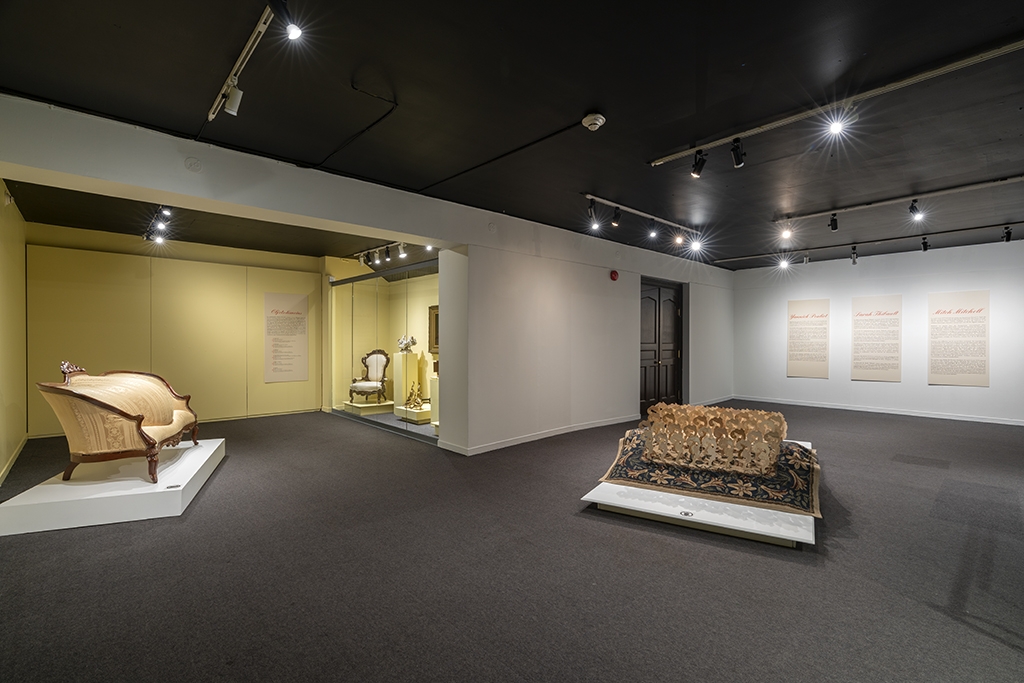
Contemporary works of art have been positioned in such a way as to engage in dialogue with objects selected by the curator, Marie Perrault. These latter “control objects” are taken from the Château Dufresne’s collection and belonged to the residence’s first occupants. A Baroque chair and a porcelain figurine are representative of a high-life ideal revisited by Yannick Pouliot. A bronze andiron, an inlaid cigar case and a Louis XVI chair play off against the comments of Mitch Mitchell and Sarah Thibault on craft-related skill and ornamentation. A period painting by Théophile Emmanuel Duverger entitled Interior Scene Witha Young Woman Hanging a Painting features one of the apparently innocuous acts involved in decorating residential interiors, as seen by today’s artists.
